warning AUDI S4 2018 Owners Manual
[x] Cancel search | Manufacturer: AUDI, Model Year: 2018, Model line: S4, Model: AUDI S4 2018Pages: 403, PDF Size: 66.81 MB
Page 362 of 403
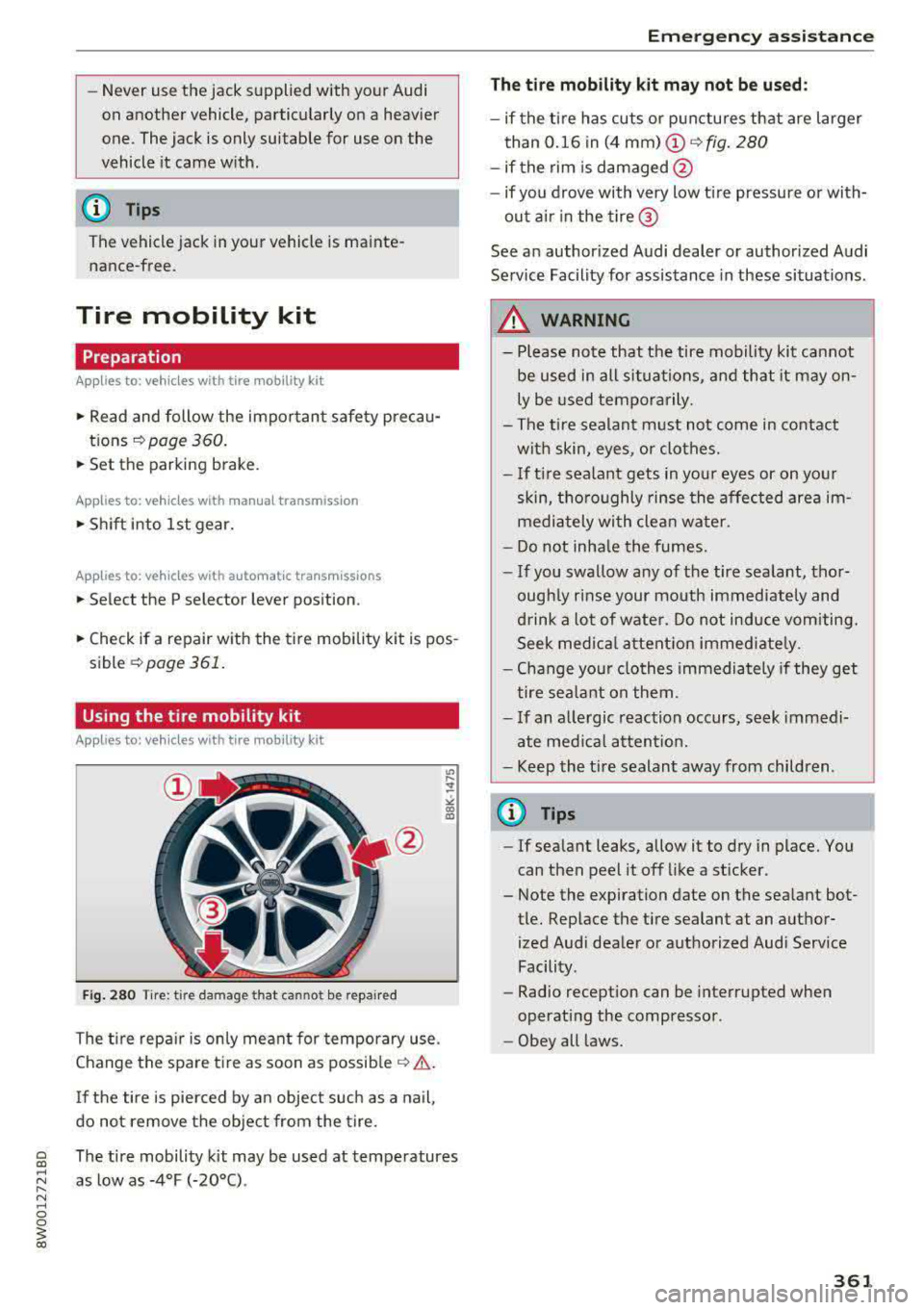
-Never use the jack supplied with your Audi
on another vehicle, particularly on a heav ier
one. The jack is only suitable for use on the
vehicle it came w ith .
(D Tips
The vehicle jack in your vehicle is mainte
nance-free.
Tire mobility kit
Preparation
Appl ies to: vehicles with tire mobility kit
• Read and follow the impor tant safety p recau
t ions
q page 360.
• Set the parking b rake.
Applies to: vehicles with manual tra nsmission
• Shift into 1st gear.
Applies to: vehicles with automatic transm issions
• Select the P select or lever posit ion .
• Check if a repair with the t ire mobi lity kit is pos
sibl e
qpage 361 .
Using the tire mobility kit
Applies to: ve hicl es with tire mobility kit
@
Fig. 280 Tire : tire da mag e t hat ca nnot be repa ired
The t ire repa ir is only mea nt for temporary use .
Change the spare tire as soon as possib le
q ,&. .
If the tire is pie rced by a n object such as a nail,
do not remove the object from the tire.
~ The t ire mobility kit may be used at temperatures
~ "' as low as -4°F (-20°C) .
" N ~ 0 0
~ co
Emergen cy a ssis tanc e
The tire mobility kit may not be used :
-if the tir e has cuts or p unctures that are larger
than 0.16 in (4 mm)
(D ~ fig. 280
- if the rim is damaged @
- if you drove with very low t ire pressure or wi th-
out ai r in the tire @
See a n author ized Audi dealer or authorized Audi
Service Facility for assistance in these situations .
,&. WARNING
-
- Please note that the tire mobility kit ca nnot
be used in all situations, a nd that it may
on
ly be used temporarily.
- The tire sealant m ust not come in contact
with skin, eyes , o r clothes.
- I f ti re sealant gets in you r eyes or on yo ur
skin, t ho roughly rinse the affected area
im
mediately with clean water .
- Do not inha le the fumes.
- If you swallow any of the tire sea lant, thor-
ough ly rinse your mouth immediately and
d rink a lot of water. Do not induce vomi ting.
Seek med ic al attent ion immed iate ly.
- Change yo ur clothes immediately if they get
tire sea lant on them .
- I f an a lle rgic reaction occurs, seek immed i
ate med ica l atten tion .
- Keep the t ire sealant away from children .
(D Tips
-If sea lant leaks, allow itto dry in place. You
can then peel it off like a st icker.
- Note the expiration date on the sea lant bot
tle. Replace the t ire sealant at an author
ized Aud i dea ler or authorized Aud i Serv ice
Facility .
- Radio reception can be interrupted when
operating the compresso r.
- Obey all laws.
361
Page 363 of 403
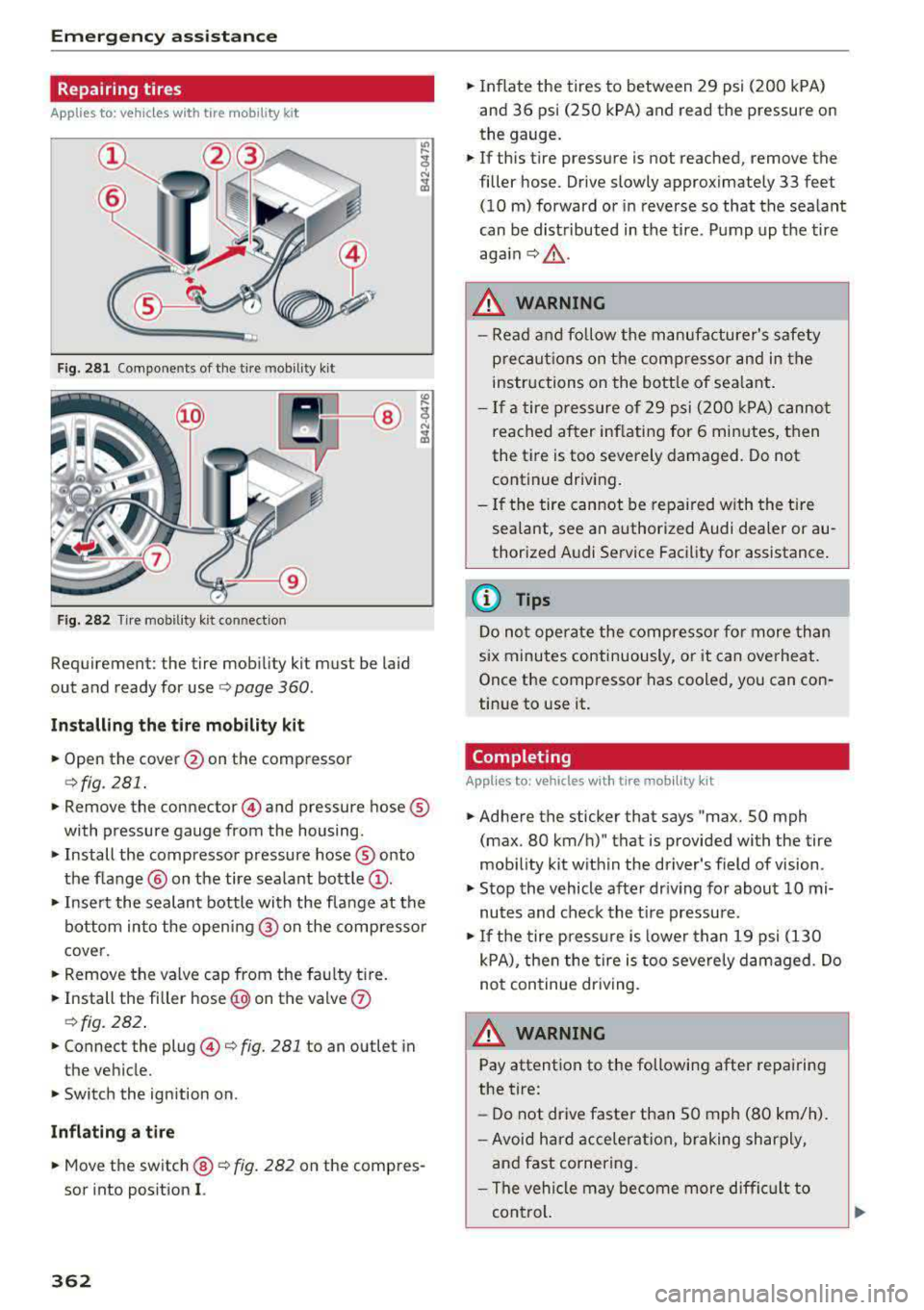
Emergency assistance
Repairing tires
Applies to: vehicles w ith tire mob ility k it
Fig. 281 Components of the tire mobility kit
F ig. 282 Tire mobility k it connec tion
Requirement: the tire mobility kit must be laid
out and ready for use
o page 360.
Installing the tire mobility kit
.. Open the cover @on the compressor
¢fig. 281 .
.. Remove the connector @) and pressure hose®
with pressure gauge from the housing.
• Install the compressor pressure hose ® onto
the f lange @ on the tire sea lant bottle
(D .
.. Insert the sealant bottle with the flange at the
bottom into the opening @ on the compresso r
cover.
.. Remove the valve cap from the fau lty tire.
.. Install the filler hose @) on the valve (J)
ofig. 282 .
.. Connect the plug@¢ fig. 281 to an outlet in
the vehicle.
.. Switch the ignition on.
Inflating a tire
.. Move the switch @ o fig. 282 on the compres
sor into position
I.
362
.. Inflate the tires to between 29 psi ( 200 kPA)
and 36 psi (250 kPA) and read the pressur e on
the gauge .
.. If this tire pressure is not reached, remove the
filler hose. Drive slowly approximately 33 feet
(10 m) forward or in reverse so that the sea lant
can be distributed in the tire. Pump up th e tire
aga in¢ ,&.
.
.&_ WARNING
-Read and follow the manufacturer's safety
precaut ions on the compressor and in the
instructions on the bottle of sea lant .
- If a tire pressure of 29 psi (200 kPA) cannot
reached after inflating for 6 minutes, then
the tire is too severely damaged. Do not
continue driving.
- If the tire cannot be repa ired with the tire
sealant, see an authorized Audi dealer or au
thorized Audi Service Facility for assistance.
(D Tips
Do not operate the compressor for more than
six minutes continuously, or it can overheat.
Once the compressor has cooled, you can con
tinue to use it.
Completing
App lies to : vehicles wit h tire mob ility kit
.. Adhere the sticker that says "max. SO mph
(max . 80 km/h)" that is provided with the tire
mob ility kit with in the driver's field of vision.
.. Stop the vehicle after driv ing for about 10 mi
nutes and check the tir e pressure.
.. If the tire press ure is lower than 19 psi (130
kPA), then the tire is too severely damaged. Do
not continue driving .
.&_ WARNING
Pay attention to the following after repairing
the tire:
- Do not drive faster than SO mph (80 km/h).
- Avoid hard acceleration, braking sharply,
and fast cornering .
- The vehicle may become more difficult to
con trol.
Page 364 of 403
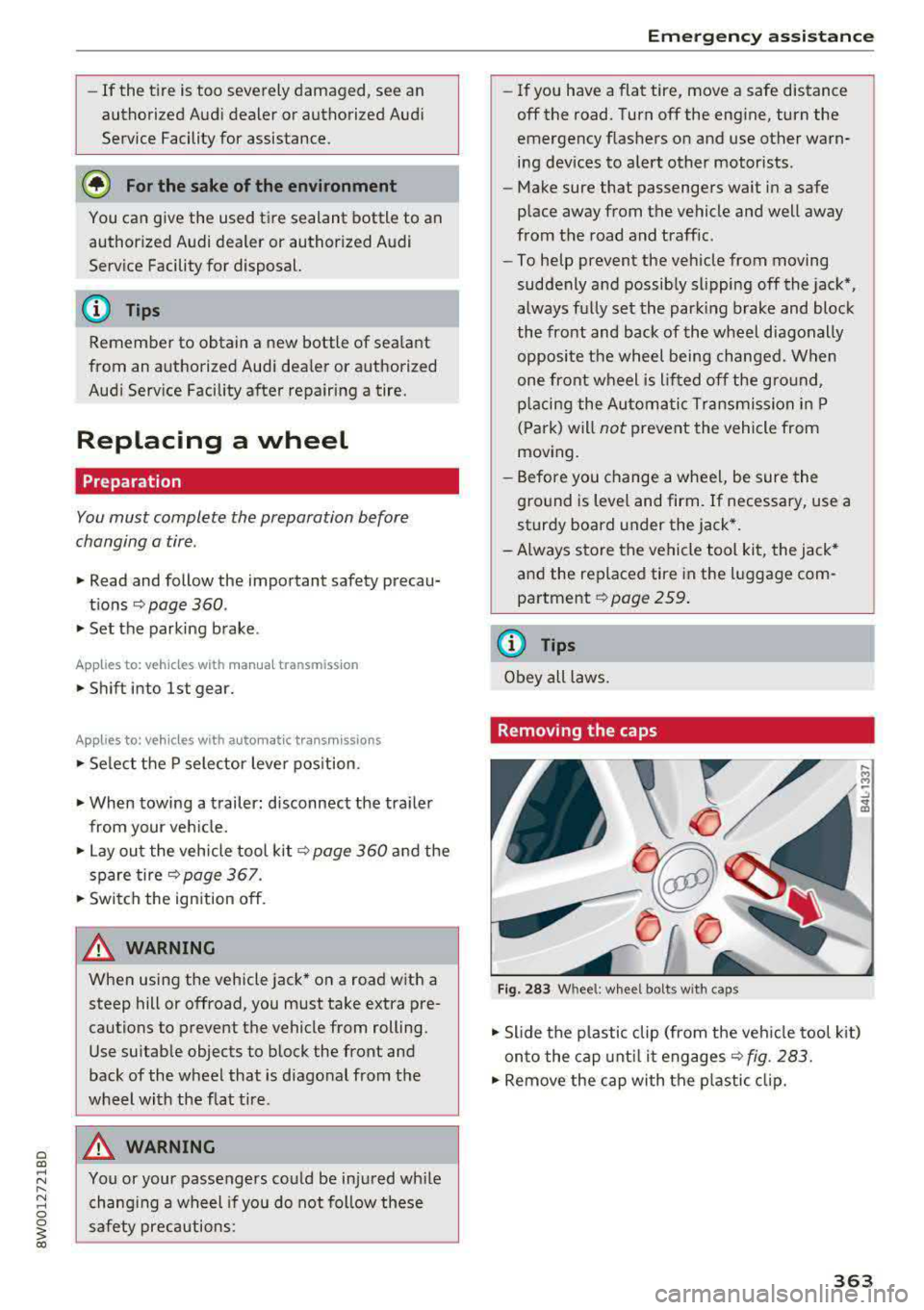
-If the t ire is too severely damaged , see an
authorized Aud i dealer or authorized Aud i
Service Facility for assistance .
@ For the sake of the environment
You can give the used tire sealant bottle to an
author ized Audi dealer or authorized A udi
Serv ice Facility for disposal.
@ Tips
Remember to obtain a new bottle of sea lant
from an authorized Audi dea ler or authorized
Audi Service Facility after repair ing a tire.
Replacing a wheel
Preparation
You must complete the preparation before
changing a tire .
.,. Read and follow the important safety precau
tions ~ page 360 .
.,. Set the parking brake .
Applies to: ve hicles with man ua l transmiss ion
.,. Shift in to 1st gear.
Applies to: ve hicles with automat ic t ra n smi ssio ns
.,. Select the P selector leve r pos ition .
.,. When towing a trailer: disconnect the tra iler
from your veh icle .
.,. Lay out the veh icle tool kit 9 page 360 and the
spare
tire ~ page 367 .
.,. Switch the ignition off .
A WARNING
When using the vehicle jack* on a road with a
steep hill or offroad, you must take extra pre
cautions to prevent the vehicle from rolling .
Use suitab le objects to b lock the front and
back of the wheel that is diagonal from the
wheel with the flat tire.
A WARNING
You or your passengers could be in ju red wh ile
chang ing a wheel if you do not follow these
safety precautions :
Emergen cy a ssis tanc e
-If you have a flat tire, move a safe distance
off the road. Turn off the eng ine, turn the
emergency flashers on and use other warn
ing dev ices to alert other motorists .
- Make sure that passengers wait in a safe
place away from the vehicle and well away
from the road and traff ic .
- To help prevent the veh icle from moving
suddenly a nd possib ly slipping off the jack*,
always fully set the park ing brake and block
the front and back of the wheel diagonally opposite the wheel being changed. When
one front wheel is lif ted off the gro und,
p la cing the Automa tic Transmission in P
(Park) will
not prevent the vehicle from
moving.
- Before you change a wheel, be sure the
g ro und is leve l and firm. If necessary, use a
sturdy board under the jack *.
- Always store the vehicle tool kit, the jack *
a nd the replaced tire in the luggage com
partment
~ page 259 .
(D Tips
Obey all laws .
Removing the caps
Fig. 283 W hee l: whee l bolt s w ith ca ps
.,. Slide the p lastic clip (from the veh icle tool k it)
on to the cap unt il it
engages ~ fig. 283.
.,. Remove the cap with the p lastic clip.
363
Page 365 of 403
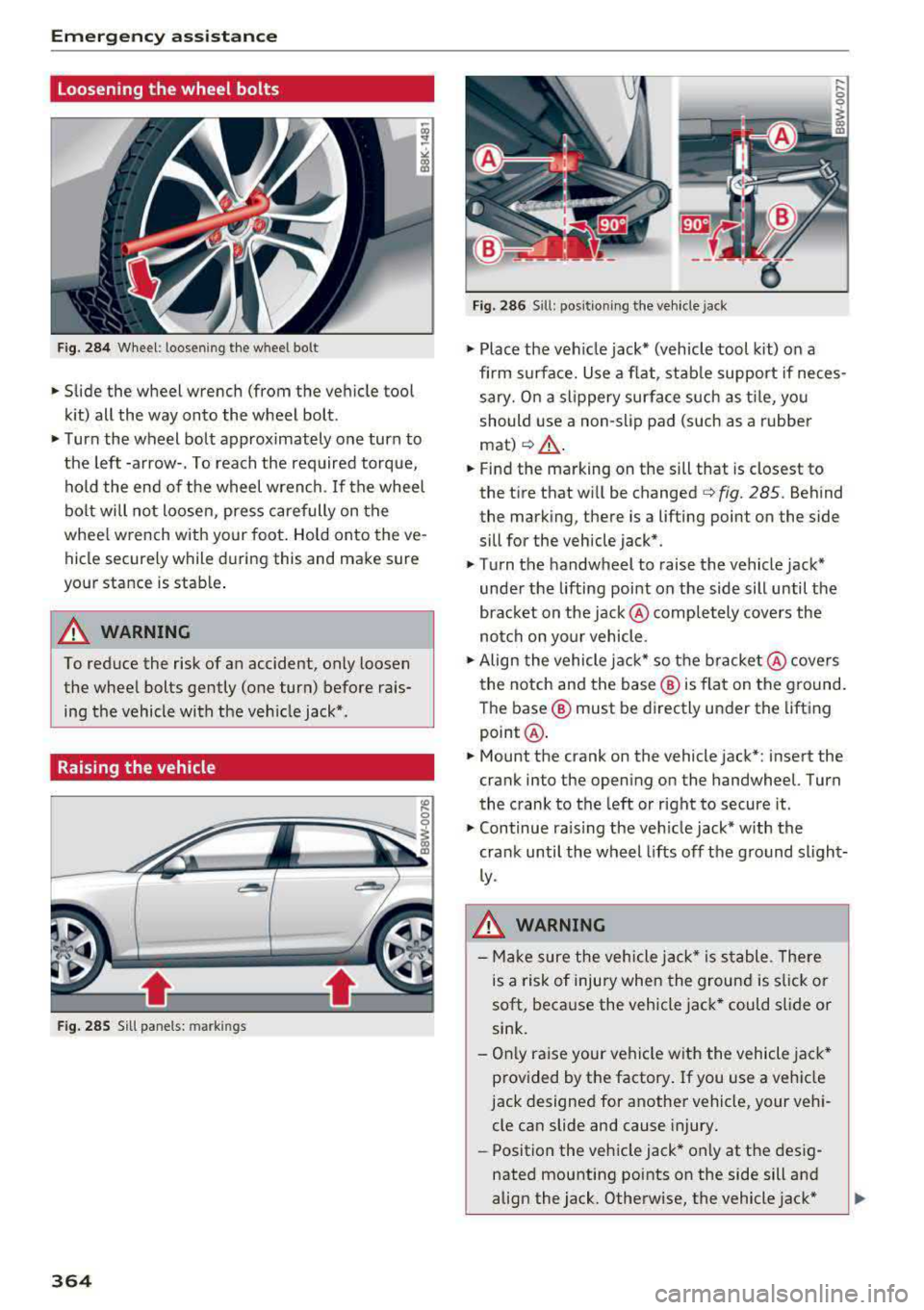
Emergency assistance
Loosening the wheel bolts
Fig. 284 Wheel: loosening the wheel bolt
• Slide the wheel wrench (from the vehicle tool
kit) all the way onto the wheel bolt.
• Turn the wheel bolt approximately one turn to
the left -arrow-. To reach the required torque,
hold the end of the wheel wrench. If the wheel
bolt will not loosen, press carefully on the
whee l wrench with your foot. Hold onto the ve
hicle securely while during this and make sure
your stance is stable .
A WARNING
To reduce the risk of an accident, only loosen
the wheel bolts gently (one turn) before rais
ing the vehicle with the veh icle jack*.
Raising the vehicle
Fig . 28S Sill panels: markings
364
Fig. 286 Sill: positio ning the vehicle jack
• Place the veh icle jack* (vehicle tool kit) on a
firm s urface. Use a flat, stable support if neces
sary. On a slippery surface such as tile, you
should use a non-slip pad (such as a rubber
mat)¢ &.
• Find the marking on the sill that is closest to
the tire that will be
changed¢ fig. 2 85 . Behind
the marking, there is a lifting point on the side
sill for the vehicle jack*.
• Turn the handwheel to raise the vehicle jack*
under the lifting point on the side sill until the
bracket on the jack @ completely covers the
notch on your vehicle.
• Align the vehicle jack* so the bracket @covers
the notch and the base ® is flat on the ground.
The base ® must be directly under the lifting
point @.
• Mount the crank on the vehicle jac k*: insert the
crank into the opening on the handwheel. Turn
the crank to the left or right to secure it.
• Continue ra is in g the veh icle jack* with the
crank until the wheel lifts off the ground slight
ly.
A WARNING
- Ma ke sure the vehicle jack* is stable. Th ere
is a risk of injury when the ground is slick or
soft, because the vehicle jack* could slide or
sink.
- Only raise your vehicle with the vehicle jack*
provided by the factory . If you use a vehicle
jack designed for another vehicle, your vehi
cle can slide and cause injury.
- Position the vehicle jack* only at the desig
nated mounting points on the side sill and
align the jack. Otherwise, the vehicle jack*
Page 366 of 403
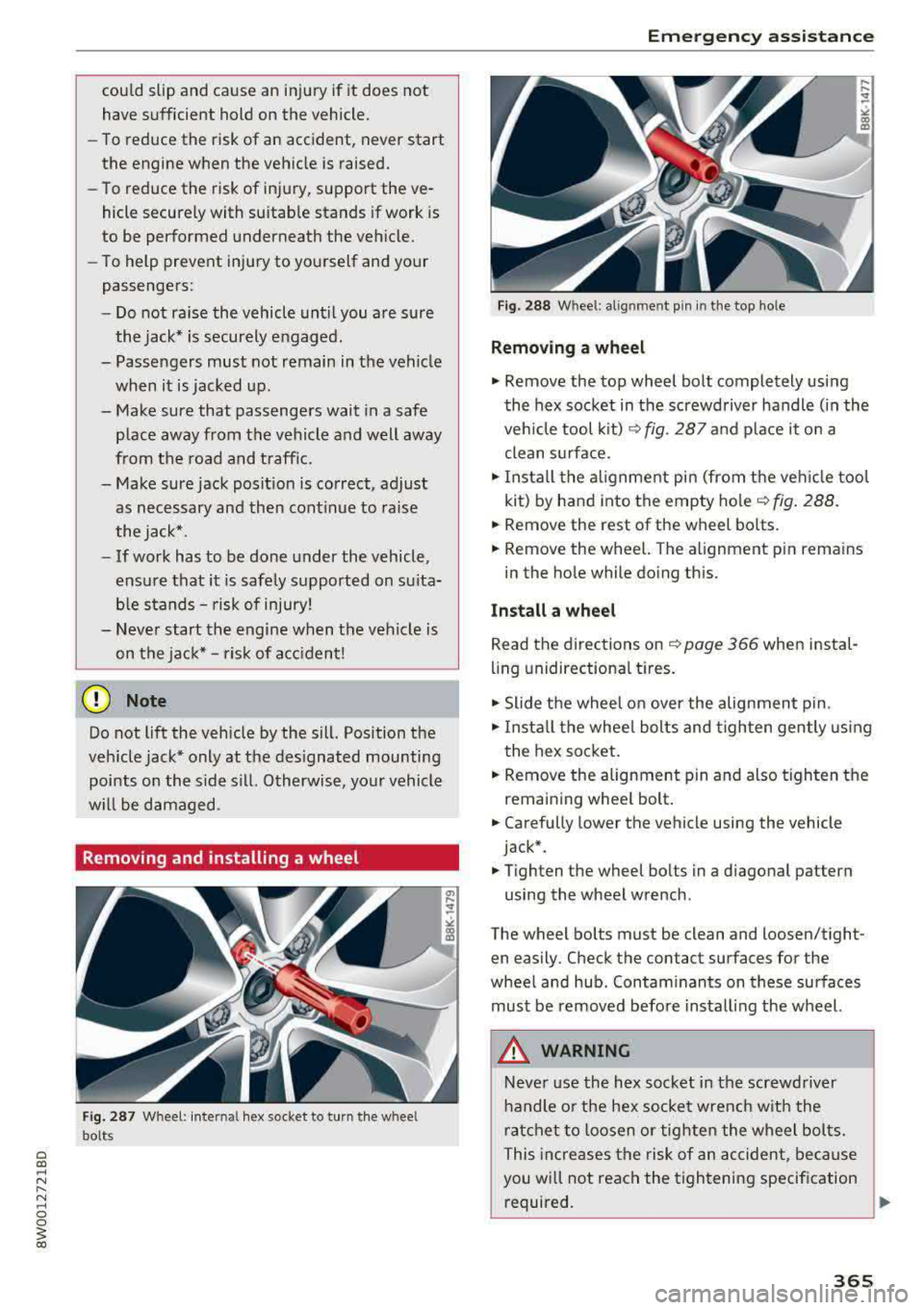
could slip and cause an injury if it does not
have sufficient hold on the vehicle.
- To reduce the risk of an accident, never start
the engine when the vehicle is raised.
- To reduce the risk of injury, support the ve
hicle securely with suitable stands if work is
to be performed underneath the vehicle.
- To help prevent injury to yourself and your
passengers:
- Do not raise the vehicle until you are sure the jack* is securely engaged.
- Passengers must not remain in the vehicle when it is jacked up.
- Make sure that passengers wait in a safe
place away from the vehicle and well away
from the road and traffic.
- Make sure jack position is correct, adjust as necessary and then continue to raise
the jack*.
- If work has to be done under the vehicle, ensure that it is safely supported on suita
ble stands
-risk of injury!
- Never start the engine when the vehicle is on the jack*
-risk of accident!
(D Note
Do not lift the vehicle by the sill. Position the
vehicle jack* only at the designated mounting points on the side sill. Otherwise, your vehicle
will be damaged.
Removing and installing a wheel
Fig. 287 Wheel: inte rnal hex socket to turn the whee l
bolts
Emergency assistance
Fig. 288 Whee l: alignment pin in the top ho le
Removing a wheel
.,. Remove the top wheel bolt completely using
the hex socket in the screwdriver handle (in the
vehicle tool kit)
~fig. 287 and place it on a
clean surface.
.,. Install the alignment pin (from the vehicle tool
kit) by hand into the empty
hole ~ fig. 288.
.,. Remove the rest of the wheel bolts.
.,. Remove the wheel. The alignment p in remains
in the hole while doing this.
Install a wheel
Read the directions on~ page 366 when instal
ling unidirectional tires.
.,. Slide the wheel on over the alignment pin .
.,. Install the wheel bolts and tighten gently using
th e hex socket.
.,. Remove the alignment pin and also tighten the
remai ning wheel bolt.
.,. Carefully lower the vehicle using the vehicle
jack*.
.,. Tighten the wheel bolts in a diagonal pattern
using the wheel wrench .
The wheel bolts must be clean and loosen/tight
en easily. Check the contact surfaces for the
wheel and hub . Contaminants on these surfaces
must be removed before installing the wheel.
A WARNING
Never use the hex socket in the screwdriver
handle or the hex socket wrench with the
ratchet to loosen or tighten the wheel bolts.
This increases the risk of an accident, because
you will not reach the tightening specification
required .
~
365
Page 367 of 403
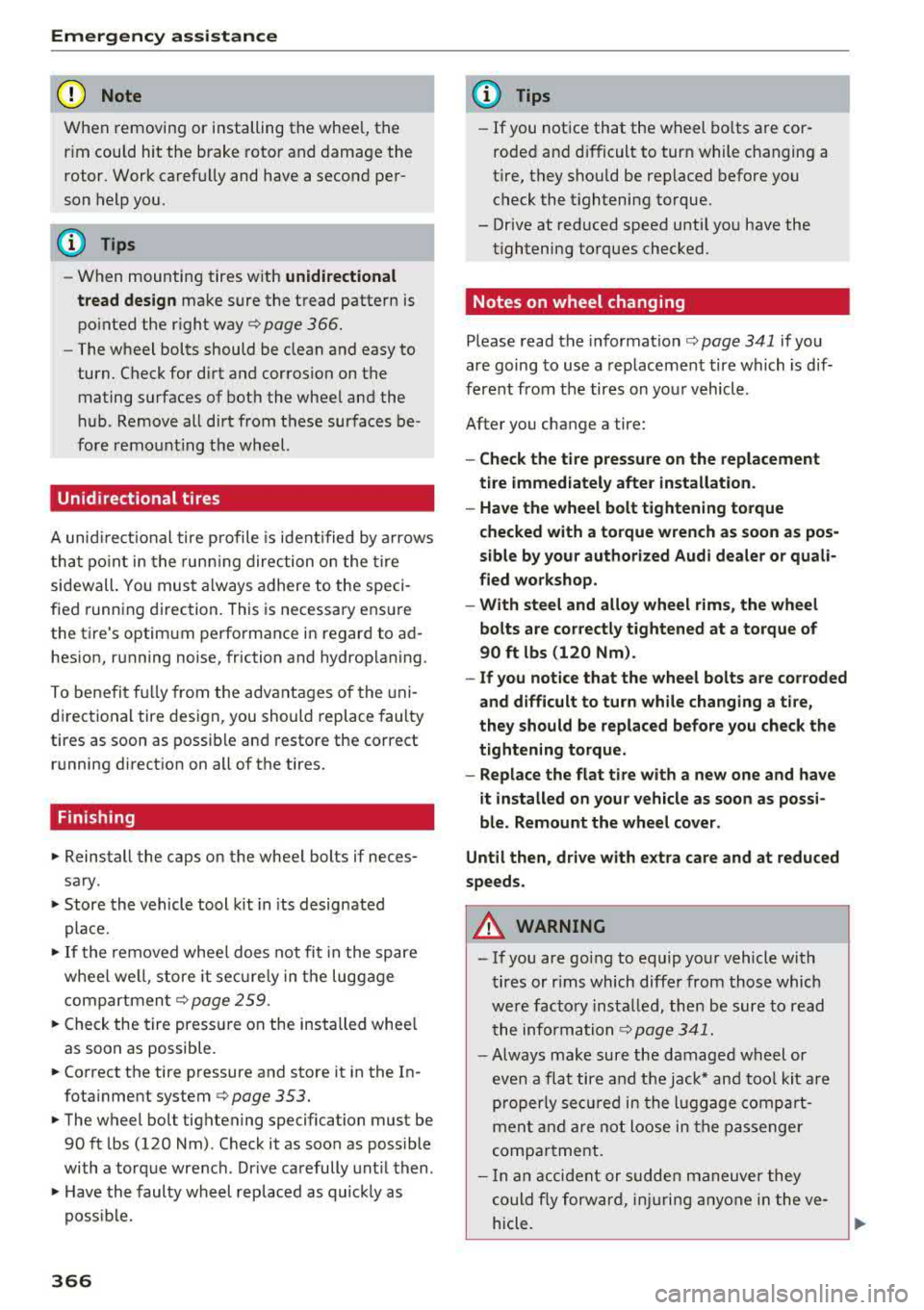
Emergency assistance
CJ) Note
When removing or installing the whee l, the
r im could hit the brake rotor and damage the
rotor. Work ca ref ull y and have a second pe r
son help you.
@ Tips
- When mounting tires w ith unidirectional
tread design
ma ke s ure the t read pattern is
po inted the r ight
way ¢ page 366.
-The wheel bolts should be clean and easy to
turn. Check for d irt and cor ros ion on the
mating s urfaces of both the wheel and the
h ub. Remove all dirt from t hese surfaces be
fo re re mo unt ing th e wheel.
Unidirectional tires
A unid irec tional tire p rofile is ident ified by a rrows
th at poin t in the run nin g dir e cti on o n the tire
sidewall. You mus t always a dhere to the speci
fied running d irec tion. This is necessary ens ure
the t ire's optim um perfo rmance in regar d to a d
hes ion, r unning noise, fr iction and hydrop la ning.
T o be nefi t fu lly fro m the adv ant ages of the uni
d irect ional tire des ign, you sho uld replace faulty
tires as soon as possi ble an d restore the correct
r u nning di rect io n on all of the tires.
Finishing
.,. Reinstall the caps on the whee l bolts if neces
sary .
.,. Store the vehicle tool kit in its designated
place .
.,. If the re m oved whee l does not fi t in the spa re
whee l we ll, store it se cur ely in t he luggage
com partmen t¢ page 2 59.
.,. Check the tire press ure on the ins talled whee l
as soon as possible.
.,. Co rrect the tire p ressure and store it in the I n
fota inment system
¢ page 353 .
.,. The wheel bo lt tightening specification must be
90 ft lbs (120 Nm) . Check it as soon as poss ible
with a torq ue wrenc h. Dr ive ca refully unt il t hen .
.,. Have th e faulty wheel rep laced as quic kly as
poss ible.
366
(D Tips
-If you not ice that t he w heel bo lts a re cor
rode d and difficult to tur n while changing a
t ir e, t hey s hou ld be replaced befo re yo u
check the t ightening torque.
- Drive at red uce d speed unti l yo u have the
t ightening to rques checked.
· Notes on wheel changing
Please read t he informat ion¢ page 341 if yo u
are going to use a replacemen t tire which is d if
ferent from the tires on yo ur vehicle .
After you change a tire:
- Check the tire pressure on the replacement
tire immediately after installation.
- Have the wheel bolt tightening torque
checked with a torque wrench as soon as pos
sible by your authorized Audi dealer or quali
fied workshop.
- With steel and alloy wheel rims, the wheel
bolts are cor rectly tightened at a torque of
90
ft lbs (120 Nm) .
- If you notice that the wheel bolts are corroded
and difficult to turn while changing a tire,
they should be replaced before you check the
tightening torque .
- Replace the flat tire with a new one and have
it installed on your vehicle as soon as possi
ble. Remount the wheel cover .
Until then, dr ive with e xtra care and at reduced
speeds.
A WARNING
- If you are going to equip yo ur vehicle wi th
t ires or r ims which diffe r from those which
we re fac to ry insta lled , th en be su re to read
t he
informa tion ¢ page 341.
- Always make sure the damage d w heel or
ev en a fla t tire and the jack* an d tool kit are
p ro p erl y se cured in t he lug gage com part
me nt an d ar e no t lo o se in the pas senge r
c o mp artme nt.
- I n an ac cident or su dde n man euver they
co uld fl y forw ard , injur ing an yone i n t he ve
hicle.
Page 368 of 403
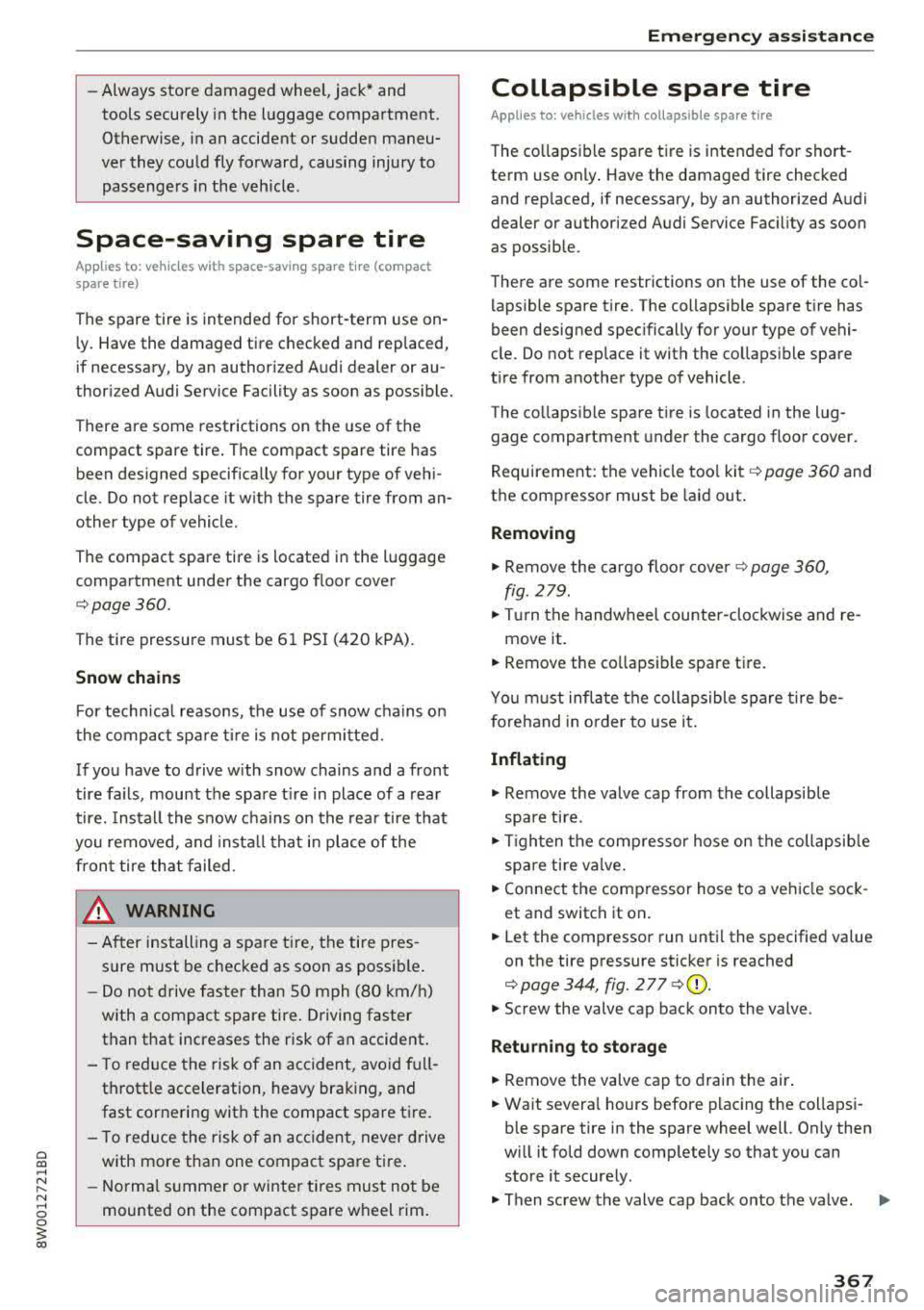
a co .... N ,....
N .... 0 0
3 co
-Always store damaged wheel, jack* and
tools securely in the luggage compartment.
Otherwise, in an accident or sudden maneu
ver they could fly forward, causing injury to
passengers in the vehicle.
Space-saving spare tire
App lies to: ve hicles with space-saving spare t ire (co mpact
spare tire)
The spare tire is intended for short -term use on
ly. Have the damaged tire checked and replaced,
if necessary, by an authorized Audi dealer or au
thorized Audi Service Facility as soon as possible.
There are some restrictions on the use of the
compact spare tire . The compact spare tire has
been designed specifically for your type of vehi
cle. Do not replace it with the spare tire from an
other type of vehicle.
The compact spare tire is located in the luggage
compartment under the cargo f loor cover
c::>page360.
The tire pressure must be 61 PSI (420 kPA).
Snow chains
For technical reasons, the use of snow chains on
the compact spare tire is not permitted.
If you have to drive with snow chains and a front
tire fails, mount the spare t ire in place of a rear
tire. Install the snow chains on the rear tire that
you removed, and insta ll that in place of the
front tire that failed.
A WARNING
-After installing a spare tire, the tire pres
sure must be checked as soon as possible.
-Do not drive faster than 50 mph (80 km/h)
with a compact spare tire. Driving faster
than that increases the risk of an accident.
-T o reduce the risk of an accident, avoid full
thrott le acceleration, heavy braking, and
fast cornering with the compact spare tire.
-To reduce the risk of an accident, never drive
with more than one compact spare tire.
-Normal summer or winte r tires must not be
mounted on the compact spare wheel rim.
Emergency assistance
Collapsible spare tire
Applies to: vehicles with collapsible spare tire
The collapsible spare tire is intended for short
term use only . Have the damaged tire checked
and rep laced, if necessary, by an authorized A udi
dealer or authorized Audi Service Facility as soon
as possible.
There are some restrictions on the use of the co l
l apsible spare tire. The collapsible spare tire has
been designed spec ifically for your type of vehi
cle. Do not replace it with the collaps ible spare
t ir e from another type of vehicle .
The co llapsible spare tire is located in the lug
gage compartment under the cargo floor cover.
Requirement: the vehicle too l kit
c::> page 360 and
the compressor must be laid out .
Removing
"' Remove the cargo floo r cover c::> page 360,
fig. 279.
"' Turn the handwheel counter-clockwise and re-
move it.
"' Remove the co llapsible spare tire.
You must inflate the collapsible spare tire be
fo rehand in order to use it.
Inflating
"' Remove the valve cap from the collapsible
spare tire.
"'Tighten the comp ressor hose on the collapsible
spare tire valve.
"'Connect the comp ressor hose to a vehicle soc k
et and switch it on .
"'Let the compressor run until the specified value
on the tire pressure sticker is reached
c::> page 344, fig. 277 c::>(D.
"'Screw the valve cap back onto the valve.
Returning to storage
"'R emove the valve cap to drain the air .
"'Wait severa l hours before placing the collapsi
ble spare tire in the spare wheel well. Only then
w ill it fold down comp letely so that you can
store it securely .
"' Then screw the valve cap back onto the valve . ..,_
367
Page 369 of 403
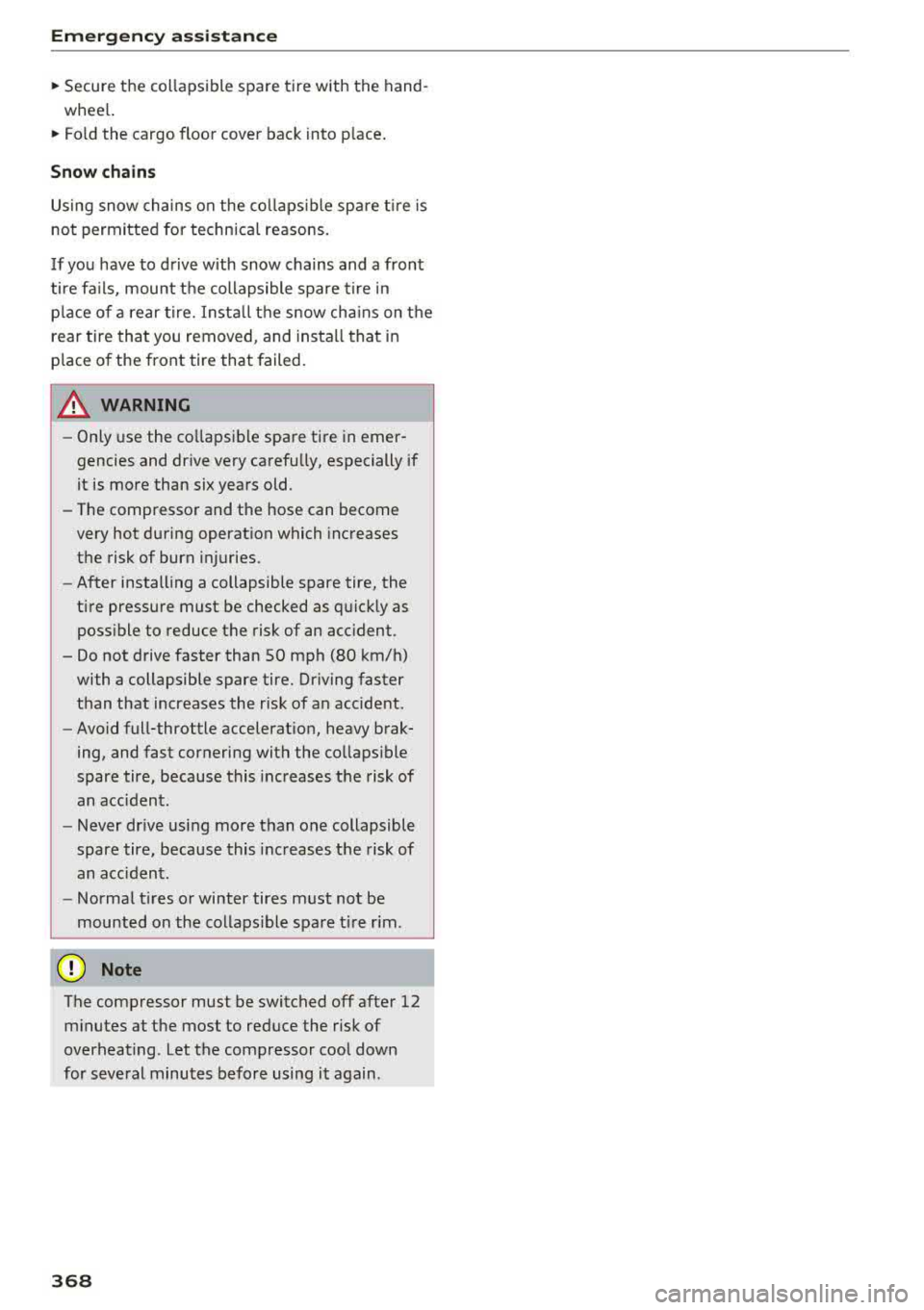
Emergency assistance
"'Secure the collapsible spare tire with the hand -
whee l.
"'Fo ld the cargo floor cover back into p lace.
Snow chains
Using snow chains on the collapsible spare tire is
not permitted for technical reasons.
If you have to drive with snow chains and a front
tire fa ils, mount the collapsible spare tire in
p la ce of a rear tire. Insta ll the snow cha ins on the
rear tire that you removed, and install that in
p lace of the front tire that failed.
A WARNING
-
- Only use the collapsible spare tire in emer
gencies and drive very carefully, especially if
it is more than six years old .
- The compressor and the hose can become
very hot during operation which increases
the risk of burn injuries.
- After installing a collapsible spare tire, the
t ir e pressure must be checked as quickly as
poss ible to reduce the risk of an acc ident.
- Do not drive faster than 50 mph (80 km/h)
with a collapsible spare tire. Driving faster
than that increases the risk of an accident .
- Avoid full-throttle acceleration, heavy brak
ing, and fast cornering with the collapsible
spare tire, because this increases the risk of
an accident .
- Never drive using more than one collapsible
spare tire, because this increases the risk of
an accident.
- Normal tires or winter tires must not be
mounted on the collaps ible spare tire rim.
«J:) Note
The compressor must be switched off after 12
minutes at the most to reduce the risk of
overheating . Let the compressor cool down
for several minutes before using it again.
368
Page 371 of 403
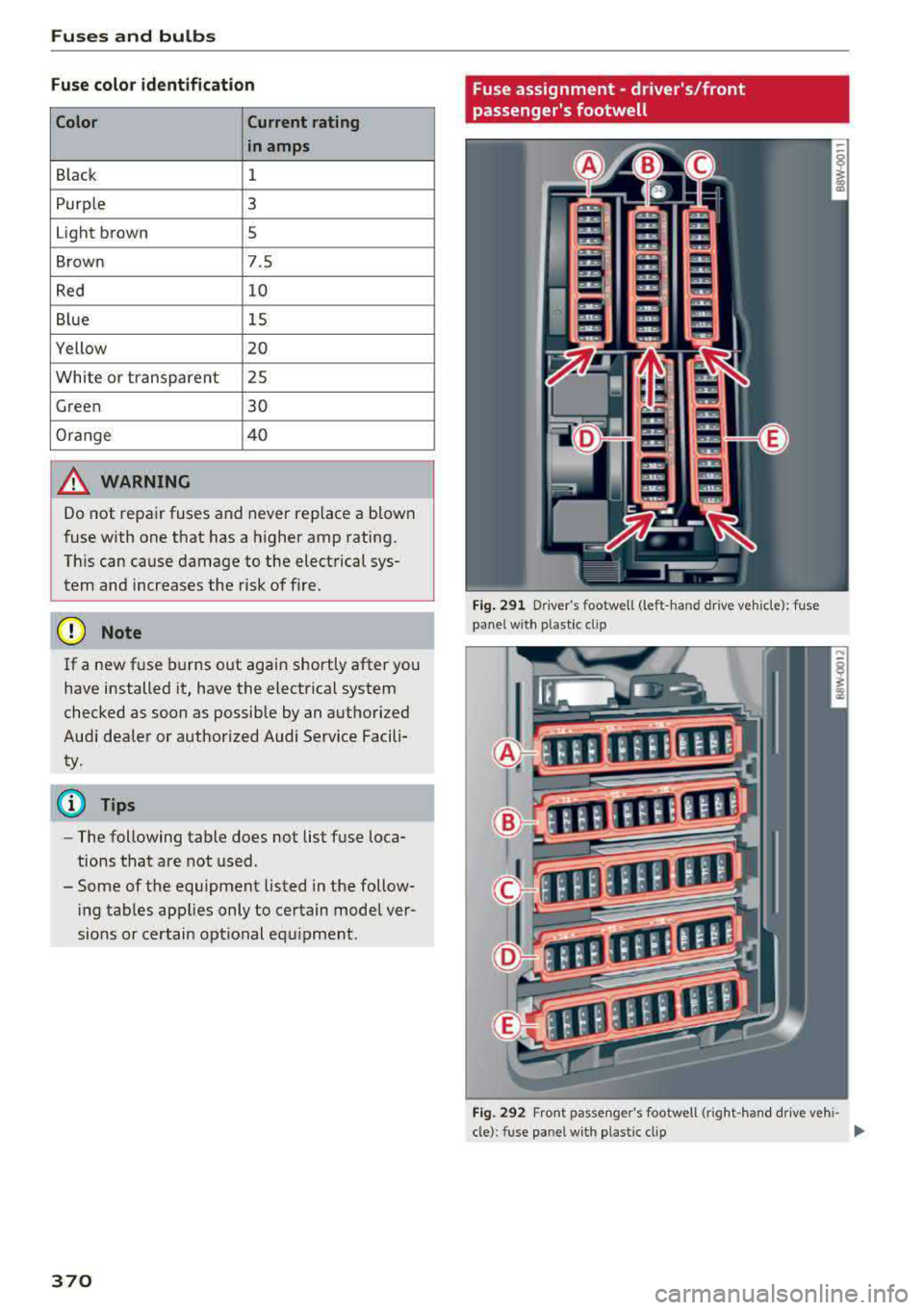
Fuses and bulbs
Fuse color identification
Color Current rating
in amps
Black 1
Purple 3
Light brown 5
Brown 7 .5
Red 10
Blue 15
Yellow 20
White or transparent 25
Green 30
Orange 40
A WARNING
Do not repair fuses and never replace a blown
fuse with one that has a higher amp rating.
This can cause damage to the electrical sys
tem and increases the risk of fire.
(D Note
If a new fuse burns out again shortly after you
have installed it, have the electrical system
checked as soon as possible by an authorized
Audi dealer or authorized Audi Service Facili
ty .
Q) Tips
-The following table does not list fuse loca
tions that are not used.
- Some of the equipment listed in the follow
ing tables applies only to certain model ver
sions or certain optional equipment.
370
Fuse assignment - driver's/front
passenger's footwell
Fig. 291 Driver's footwell (left-hand drive vehicle): fuse
panel with plas tic clip
Fig. 292 Front passe nger's footwell (right -hand drive vehi-
cle): fuse panel with plastic clip
Ill>
Page 374 of 403
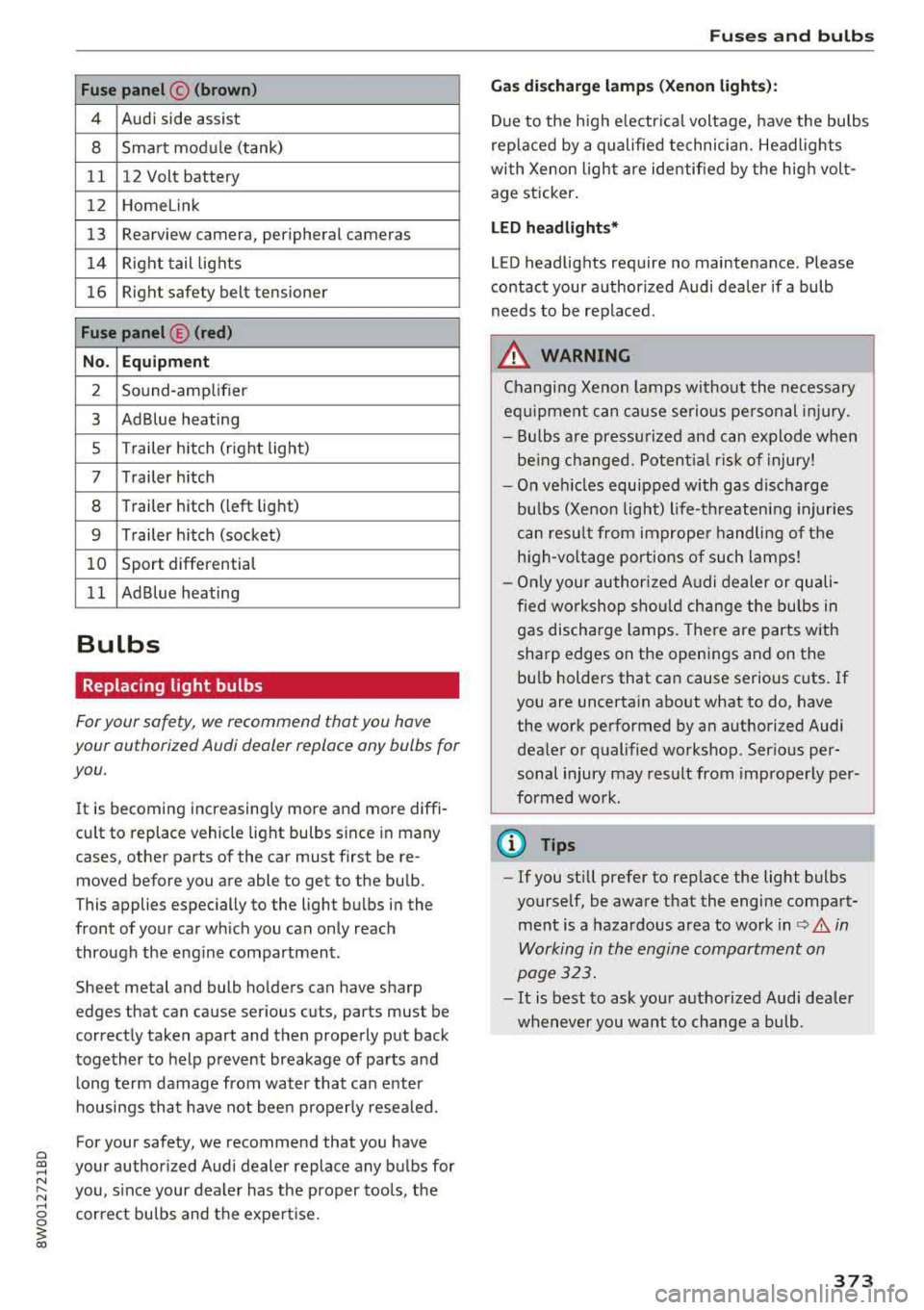
a co .... N ,....
N .... 0 0
3 co
Fuse panel © (brown)
4 Audi side assist
8 Smart module (tank)
11 12 Volt battery
12 Homelink
13 Rearview camera, peripheral cameras
14 Right tail lights
16 Right safety belt tensioner
Fuse panel © (red)
No . Equipment
2 Sound-amp
lifier
3 AdBlue heating
5 Trailer hitch (right light)
7 Trailer h
itch
8 Trailer hitch (left light)
9 Trailer h itch (socket)
10 Sport differential
11 AdBlue heating
Bulbs
Replacing light bulbs
For your safety, we recommend that you have
your authorized Audi dealer replace any bulbs for
you.
It is becoming increasingly more and more diffi
cult to replace vehicle light bulbs since in many
cases, other parts of the car must first be re moved before you are able to get to the bulb.
This applies especially to the light bulbs in the
front of your car which you can only reach
through the engine compartment.
Sheet metal and bulb holders can have sharp
edges that can cause serious cuts, parts must be
correctly taken apart and then properly put back
together to help prevent breakage of parts and
l ong term damage from water that can enter
housings that have not been properly resealed.
For your safety, we recommend that you have
your author ized Audi dealer replace any bulbs for
you, s ince your dealer has the proper tools, the
correct bulbs and the expert ise.
Fuses and bulbs
Gas discharge lamps (Xenon lights) :
Due to the high e lectr ical voltage, have the bulbs
replaced by a qualified technician. Headlights
with Xenon light are identified by the high volt
age sticker .
LED headlights*
LED headlights require no maintenance. Please
contact your authorized Audi dealer if a bulb
needs to be replaced .
.&, WARNING
Changing Xenon lamps without the necessary
equipment can cause serious personal injury.
- Bulbs are pressurized and can explode when
be ing changed. Potential risk of injury!
- On veh icles equipped with gas discharge
bu lbs (Xenon light) life-threatening injuries
can resu lt from improper handling of the
h ig h-vo ltage portions of such lamps!
- Only your authorized Audi dealer or quali
fied workshop should change the bulbs in
gas discharge lamps. There are parts with
sharp edges on the openings and on the
bulb holders that can cause serious cuts. If
you are uncertain about what to do, have the work performed by an authorized Audi
dealer or qualified workshop. Ser ious per
sonal injury may result from improperly per
formed work.
(D Tips
- If you st ill prefer to replace the light bulbs
yourself, be aware that the engine compart ment is a hazardous area to work
in¢ A in
Working in the engine compartment on
page 323.
- It is best to ask your authorized Audi dealer
whenever you want to change a bulb .
373